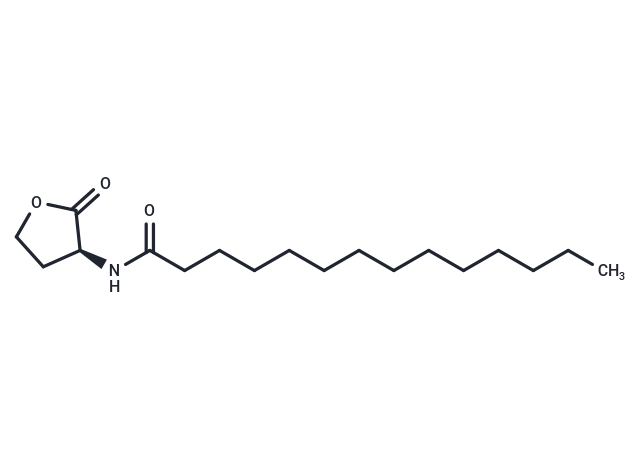Shopping Cart
Remove All Your shopping cart is currently empty
Your shopping cart is currently empty
N-tetradecanoyl-L-homoserine lactone is a long-chain N-acyl homoserine lactone (AHL) and bacterial quorum sensing signal molecule that promotes diatom growth and upregulates genes involved in intracellular signalling.

| Pack Size | Price | USA Warehouse | Global Warehouse | Quantity |
|---|---|---|---|---|
| 5 mg | $41 | - | In Stock | |
| 10 mg | $73 | - | In Stock |
| Description | N-tetradecanoyl-L-homoserine lactone is a long-chain N-acyl homoserine lactone (AHL) and bacterial quorum sensing signal molecule that promotes diatom growth and upregulates genes involved in intracellular signalling. |
| Synonyms | (S)-N-tetradecanoyl-HSL |
| Molecular Weight | 311.46 |
| Formula | C18H33NO3 |
| Cas No. | 202284-87-5 |
| Smiles | N(C(CCCCCCCCCCCCC)=O)[C@H]1CCOC1=O |
| Color | White |
| Appearance | Solid |
| Storage | Powder: -20°C for 3 years | In solvent: -80°C for 1 year | Shipping with blue ice/Shipping at ambient temperature. | |||||||||||||||||||||||||||||||||||
| Solubility Information | DMF: 30 mg/mL (96.32 mM), Sonication is recommended. DMSO: 2 mg/mL (6.42 mM), Sonication is recommended. | |||||||||||||||||||||||||||||||||||
Solution Preparation Table | ||||||||||||||||||||||||||||||||||||
DMSO/DMF
DMF
| ||||||||||||||||||||||||||||||||||||
| Size | Quantity | Unit Price | Amount | Operation |
|---|

Copyright © 2015-2026 TargetMol Chemicals Inc. All Rights Reserved.